Nestled in the rolling hills just 7km outside of Cordoba, Spain, lies the magnificent ruins of Madinat Al-Zahra, a once-thriving palace city built during the Islamic Golden Age. Founded in the 10th century by the Umayyad Caliphate, the city served as a symbol of power and prosperity for the Islamic empire. Its grand palaces, stunning gardens, and intricate architectural designs were renowned throughout the world, attracting visitors from far and wide.
Although the city was destroyed in the 11th century, its ruins have survived to this day, offering a glimpse into the grandeur and beauty of Islamic civilization. In this blog, I will take you on a journey through the fascinating history and culture of Medinat Al-Zahra, and explore the stunning sights that make this ancient city a must-visit destination for anyone interested in the rich heritage of Islamic Spain.
Is Madinat Al Zahra worth visiting?
Madinat Al Zahra (sometimes referred to as Medina Azahra) is absolutely worth visiting, especially if you are interested in Moorish culture and history. It was actually one of my favourite things to see in Spain along with the Cordoba Mezquita and the Art Nouveau of Barcelona. Many people have commented that it’s a bit like a ‘Moorish Pompeii’ and so if old ruined cities are your thing, don’t miss this!
Although many people do this as a quick stop off on the way to or from Cordoba as a day trip, I would recommend that you do this on a separate day. There is a large museum full of Moorish artefacts and another bus up the hill to the ruined city and so you need to spend at least 3 hours there.
You don’t need to pre-book your Madinat Al Zahra ticket as you get that on the door of the museum, but you do need to pre-book your bus there.
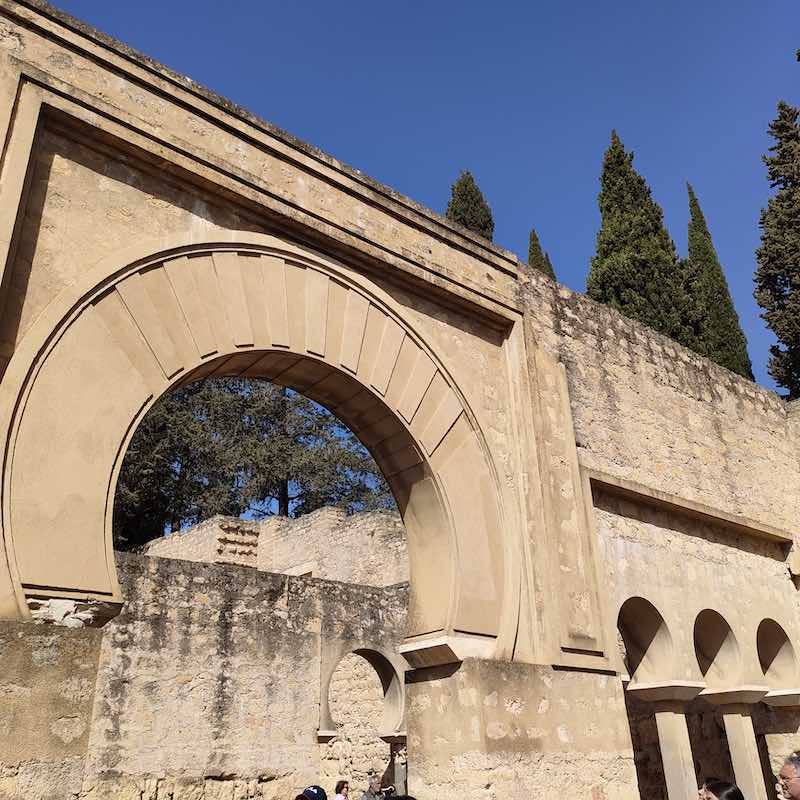
Madinat Al Zahra Tickets and How to get there
The first important thing to note is that you should book your bus for Medinat Al Zahra as early as possible – you do NOT want to be getting there in the heat of the day as there is very little shade. Book your ticket for the bus online here – it will cost €10 in cash walk on price but just €9,50 if you book online with Tourism de Cordoba here. Also by booking online you reserve your place. Sometimes, if you just turn up at the bus stop you may be told that the bus is full (completo). I would recommend booking your bus for 10am (or even earlier if they are running).
You can board the bus outside Eurostars hotel or in front of the Mercado Vitoria (board at the bus stop for the yellow line 1). You can show the driver a digital print out or the mobile phone booking (but make sure that you have plenty of charge so it doesn’t run out!) When you disembark, take note of the time you need to rebound the bus to go back – usually 3 hours after you arrive. The driver may only tell you in Spanish so you need to translate (for example ‘Una y media’ is half past 1).
The bus is going to take around 25 minutes to the Madinat Al Zahra museum site. You will go into the museum first to get your ticket (free for EU residents and €1,50 for others at the time of writing – February 2023). You will spend around half an hour to an hour in the museum where they have several artefacts including pottery, pillars and inscriptions from the site. There is also a detailed history of the Islamic period and history of the site and how it was used when it was an active city.
When you come out of the museum, you will then get on the green (verde) transfer bus to take you up the hill to the ancient ruined city. The transfer bus is INCLUDED in your bus ticket from Cordoba to Medinat Al Zahra and so show the ticket to your driver – do not pay again! You can say ‘es incluido’.
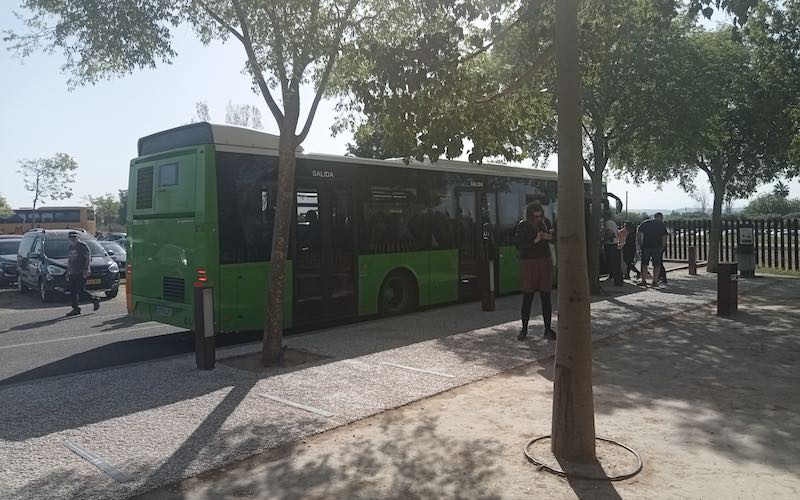
After you have spent time visiting the ancient city you can jump back on the bus to take you down the hill to the parking lot again, then wait around to reboard your transfer bus back to Cordoba.
Madinat Al Zahra – What to pack and what to wear
- Wear walking boots or comfortable trainers – there is a lot of uneven ground.
- Avoid sandals as you might end up with burnt feet!
- Pack a sun hat and sun cream.
- Wear comfortable but loose clothing – Linen or cotton pants with a comfortable T shirt are ideal.
- Plenty of charge in your phone and also a print out of your bus ticket just incase you run out of battery.
- Good camera – you will want to take plenty of amazing photos.
- At least 2 bottles of water. A refillable water bottle is also a good idea as there are a couple of water fountains on site.
- A good guide book might be useful especially if you have not booked a guide (I like the Lonely Plante Andalusia). However, it’s not essential as things are well labelled.
- Pack snacks or sandwiches as there are no food outlets, but be aware that you will NOT be allowed to eat on site of the museum or at the archaeological site. If you want to eat, there are benches near the car park.
Visiting Madinat Al Zahra – Top Travel Tips
- Book your bus in advance and as early as possible.
- Take note of your bus return time and take the transfer back down the hill at least half an hour before your big bus is due to depart – you don’t want to get stranded!
- Put on plenty of sun cream and wear a sun hat – there is very little shade.
- Take a couple of bottles of water to avoid dehydration (it can get VERY hot).
- Get your ticket at the museum and DON’T throw it away or misplace it – you will need the ticket again when you get to the archaeological site of the ruined city.
- Make the most of the museum while you are there – you can’t go back in once you have exited, you are expected to go straight on to the archaeological site.
- There are toilets at the museum and at the archaeological site – make use of them before you explore the ancient city!
- There is a tree around half way through the ancient city which provides a water fountain and some shade – I would recommend making use of that and taking a break here to avoid heat exhaustion.
- If you want to miss the crowds for photography at Madinat Al Zahra without too many people then get the earliest bus, no tour guide and whizz through the museum at fast pace. You may miss some of the museum exhibits, but you will get good pictures and avoid the crowds at the ancient city if you do it that way.
History of Madinat Al Zahra
Madinat al-Zahra, also known as the “City of Zahra”, was a palace city built during the Islamic Golden Age in the 10th century. It was founded by Abd ar-Rahman III, the first Caliph of Cordoba, as a symbol of the power and wealth of the Umayyad Caliphate.
The city was located just outside of Cordoba, Spain, and was built on a hill overlooking the surrounding valley. It featured grand palaces, stunning gardens, and intricate architectural designs, all of which were designed to showcase the artistic and cultural achievements of Islamic civilization.
Madinat al-Zahra was constructed over the course of several decades and was the largest and most magnificent palace city of its time. It served as the seat of the Caliphate and was home to over 10,000 people, including the Caliph’s family, court officials, and servants.
The city was renowned throughout the Islamic world for its beauty and grandeur. Its architectural designs were influenced by a variety of styles, including Roman, Byzantine, and Persian, and featured intricate details such as intricate mosaics, stucco carvings, and ornate arches.
Despite its splendor, Madinat al-Zahra was short-lived. The city was sacked and destroyed by Berber tribesmen in the 11th century, only a few decades after its completion. Although some of its ruins were used for building materials in later centuries, much of the city’s structures have been excavated and preserved, offering a glimpse into the rich cultural heritage of Islamic Spain.
Madinat Al Zahra Museum
The first thing that you will explore is the Madinat Al Zahra Museum. It opened in 2009 and is part of the larger complex that includes the archaeological site of Madinat al-Zahra and the Palace of Madinat al-Zahra.
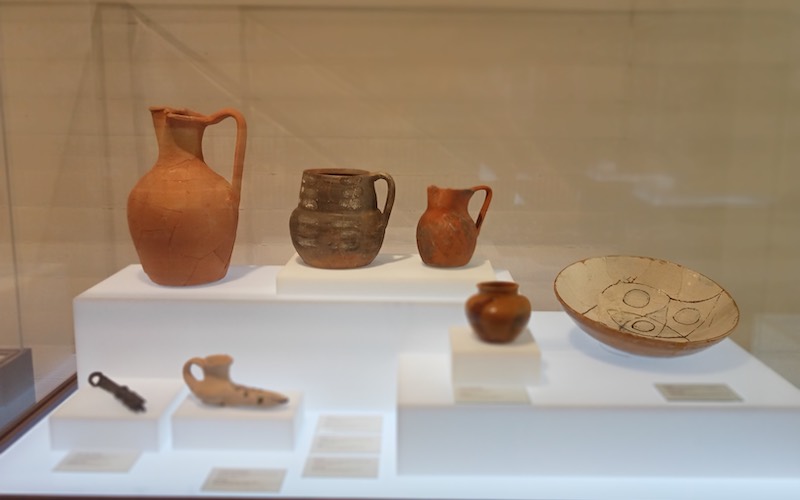
The museum houses a collection of artifacts and exhibits that tell the story of the city and its inhabitants. The exhibits include archaeological finds from the site, such as ceramics, metalwork, and architectural elements, as well as reconstructions of the city’s buildings and streets.
One of the highlights of the museum is a 180-degree audiovisual projection that recreates the city’s heyday, allowing visitors to experience the sights and sounds of the bustling metropolis. The museum also has a research center and library that is open to scholars and researchers.
The Caliphate city of Medina Azahara or Madinat Al Zahra
Travel tip – have your ticket ready again at the entrance!
The palace-city was built on a hill overlooking the valley of the Guadalquivir River, and covered an area of over 112 hectares. It was home to thousands of people, including the Caliph himself, his family, and his courtiers.
The city was designed as a complex of palaces, courtyards, gardens, and mosques, with a system of water channels and fountains that added to its beauty and grandeur. It was also known for its wealth and opulence, with its walls adorned with gold, silver, and precious stones. You will get a fantastic view over the palace city when you first go in.
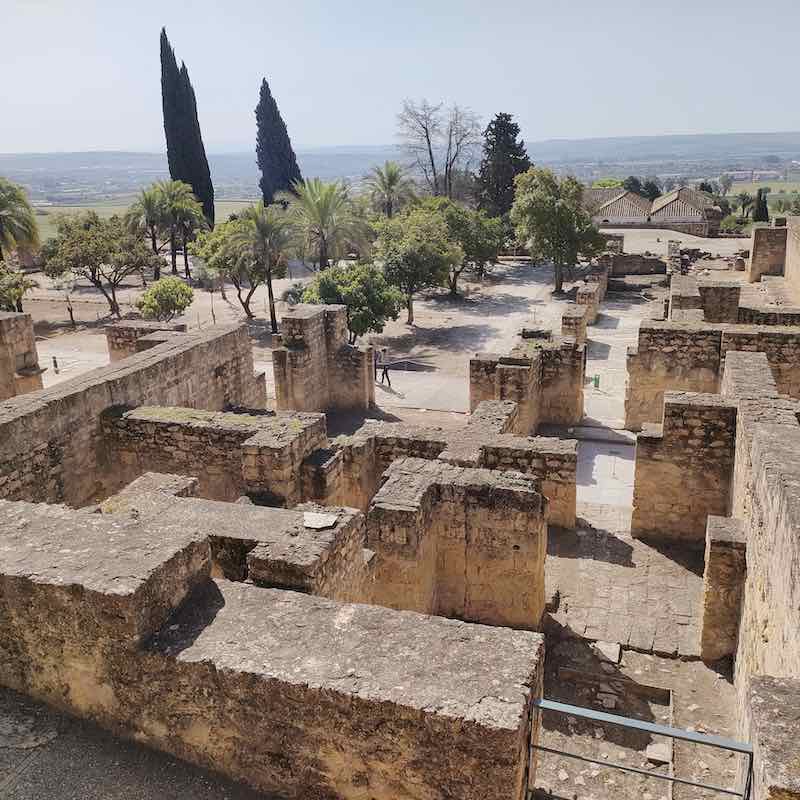
Enter the City at the North Gate
You will enter the ancient city at the North gate, which was positioned around half way along the city wall. The road leading to the gate was the fastest way to Cordoba and was known as the Camino de los Nogales (Walnut tree way!) This route was used to bring supplies into the palace (Alcazar) and some of the original stones are well preserved.
Notice how the gateway consists of a passage with several right angled turns. This was used in Islamic architecture to control access into the walled precincts. As some of the stones were looted, part of this section is a reconstruction.
Upper Basilica Building
This building must have been the headquarters of one of the Caliphal Administration departments. Materials and decoration were simple brick flooring, walls and arches are plastered with a mixture of lime and sand and painted white and red ochre.
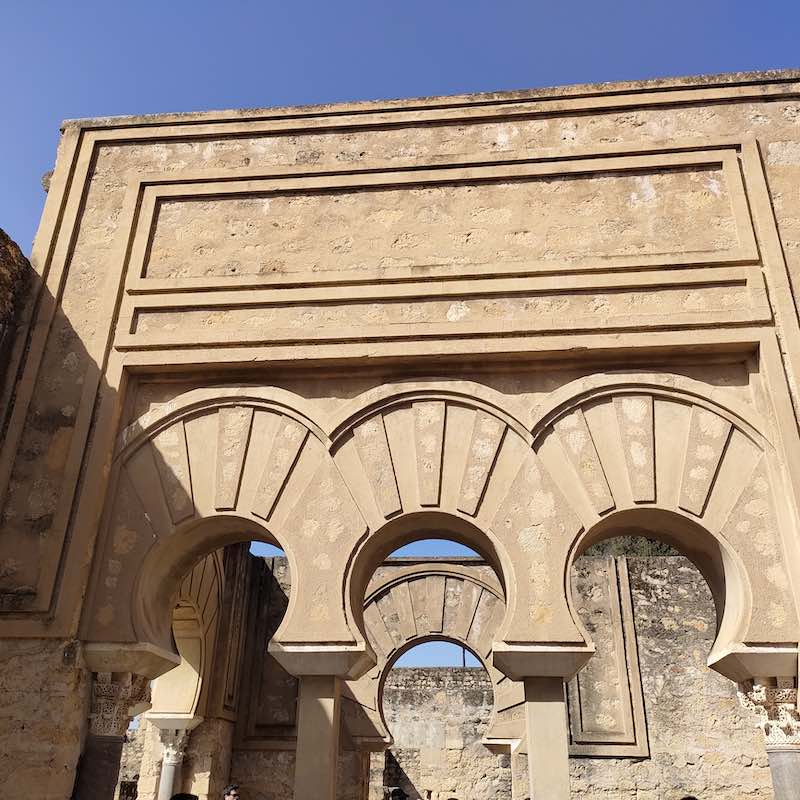
The precise purpose of the building remains unknown and it has not yet been possible to identify it with any of the buildings refers to in historical texts. It is built in the basilica style characteristic of public buildings a number of longitudinal chambers or naves separated by columns and arches and the single transverse chamber which lies before you.
It was probably built towards the end of the reign of Abd Al Rahman III as part of his radical administrative reform program. This is the most likely purpose since in addition to the building for official functions, there are a number of chambers are surrounding the courtyard where lower grade administrative staff would have worked.
The Sloping Street
Next you will walk down a sloping street which consists of two different sections. This street lead from the official buildings on the upper terrace to the great portico, which is the row of arches that you would see in front of you at this point. The street probably had a vaulted roof the paving was suitable for horses and was made of a dark stone brought from the Sierra which all tonight with a lighter hewn flags to form large squares.
the city guard and the police officials would lineup along the step toward on both sides to welcome visiting dignitaries as they moved along the established route up the ramp straight from the Great Portico.
The Great Portico
Next you come to the great portico itself – a huge row of arches that was designed to impress. The great portico was the symbolic and ceremonial entrance to the Alcazar it is a purely decorative construction meant to dazzle and impress visitors 14 open archway ran along the whole west side of the parade ground. Certain military events took place in this large square which had rooms on the north and south sides. The Caliph probably viewed the troops from a balcony built over the central arch.
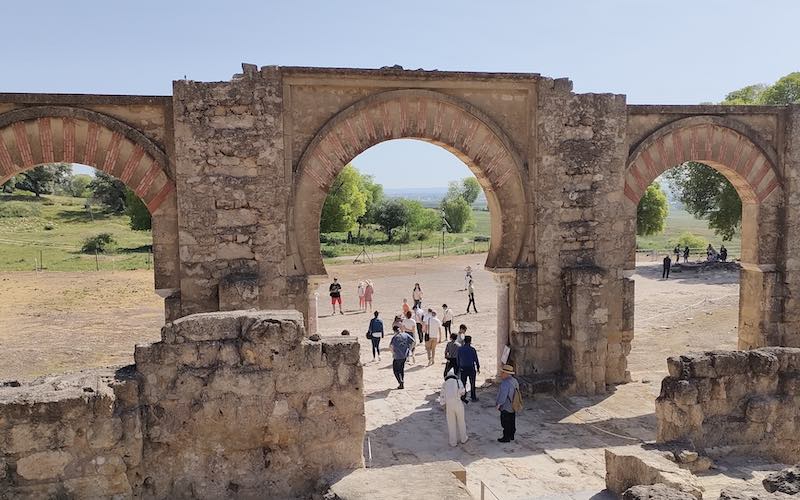
This great portico was built in the last years of Abd Al-Rahman III caliphate, or possibly during the early years of al Hakam II’s reign. However, it was soon altered – three archways were closed off on the north side in order to build guards quarters, and a sloping street was built leading from the parade ground to a new gate in the northern city wall.
Palace Stables
The stables held around 25 or 30 horses. The precinct is divided into two separate areas the eastern area was used for stores and there was probably another story supported by pillars used for a straw loft. The other area was an open air zone. The marked slope of the stone paving and the visible drains suggest that this area was used for cleaning and airy airing the stables.
the small Muse was probably intended for use by visors or ministers and other high-ranking officials who worked the large administrative buildings to the East. The piece of marble that you see is a water basin or trough recovered during excavation of this area, which was returned to its original position after restoration.
Upper and Lower Gardens
You will next come to two large gardens at the southern side of the palace. To the left is the upper garden onto which the hall of Abd Al Rahman III opens. To the right around 10 m below is another large area of garden separated from the upper Garden by a thick water with lookout towers. Together they form one architectural whole. Water for irrigation was drawn from the four large ponds in the upper garden, arranged around a building which has completely disappeared (the Central Pavilion) and also from a large pond beside the North wall of the lower garden. The current garden layout was designed in the 1960s.
House of Yafar
The next striking structure that you come to is the house of you for this in an official reception area within the Prime Minister’s residence. The official area of the residence comprises a building of a basilica-type design where official duties were performed and receptions were held. The entrance to the building was through the main doorway, which is covered in carved stone decoration. This highly intricate plaster relief work also found around the doorway of the central aisle, together with the marble flooring of the rooms, suggests that Yafar was a member of the political elite of the Umayyad state.
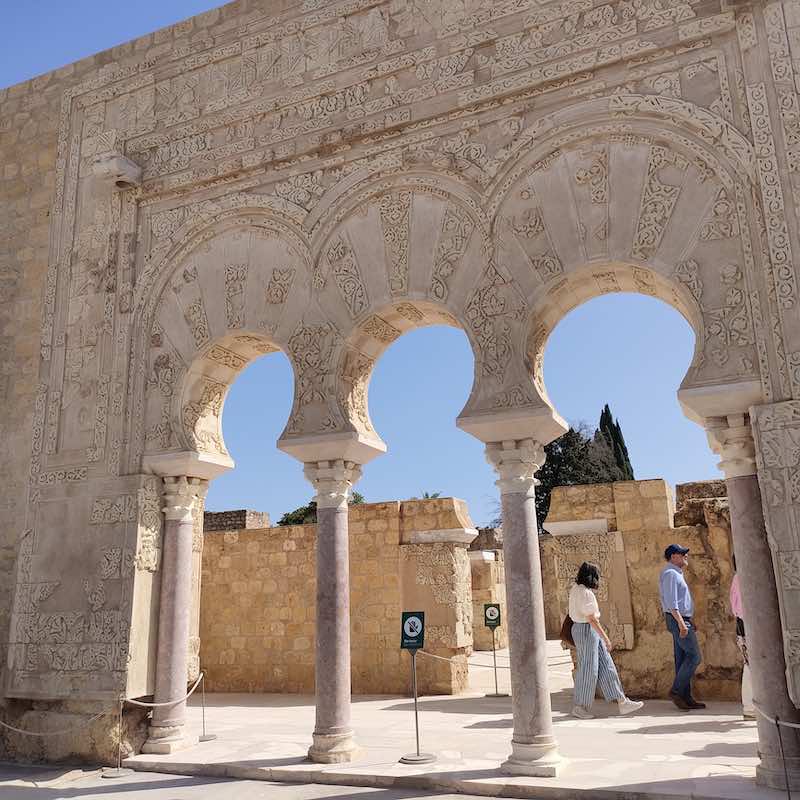
House of Yafar Private Quarters
The next rooms that you walk through or separate from the official area these are the private quarters of the Habib or Prime Minister. At the far end of this private area is a large bedroom containing for cupboards. Immediately before the bedroom is a private courtyard, paved with violet limestone tiles. At the centre, there is a marble basin into which water poured from us both, probably in the form of an animal, placed on a cube shaped pedestal.
The room to the west of the courtyard, on the left, was probably a toilet linked to the bedroom, the door opposite of step marked in the plaster of the Eastern wall.
Servants Quarters
Next you come to an additional curtain in catering area serving as an annex to the adjacent building. It is arranged in a similar fashion as the previous private quarters, with rooms and toilets opening onto the courtyard. The room in the East Wing may have been used for storage purposes or as a workspace. The two rooms and the toilet in the West Wing on the other hand, seem to be in the residence of the official in charge of the servants quarters.
The stairway to the right suggests that this is also served as a link between the servants quarters and both the residents to the north and the guard room on the upper floor.
Guards Quarters
From this next section, the guard controlled Southwood access to the Royal residence. The area was initially designed as a causeway leading to the western part of the palace. It was subsequently converted and divided into two sections.
To your left, at the far end, is the kitchen catering for the guards quarters, containing an oven and a large staircase (now largely destroyed) which led to the living quarters on the upper terrace. The other portion of the area probably had a strategic function as communications post and boardroom.
As time went on, the area was occupied by more people, and had to be subdivided into more rooms, whose partially rebuilt walls are still visible today. There was also an upper garden gallery supported by columns. The main function of this room is to control access to the noble residence in the southern part of the Alcazar.
Overall Verdict
This ancient city really is something else – as it is well preserved, it’s easy to imagine the vaulted rooves and splendid white and red glistening decoration. You can almost hear the trip-trapping of the horses in the military processions. For me, this is a sight not to be missed and is right up there with the Mezquita of Cordoba and Seville Alcazar. If there is anything that you want to ask about visiting Madinat Al Zahra, drop me a message or please comment on my blog.
Further Reading on Andalucia
If you are spending time in Andalucia there are a few other recommendations that I have for you…
- Jewish Quarter of Cordoba
- Cordoba Synagogue
- How to spend one day in Cordoba
